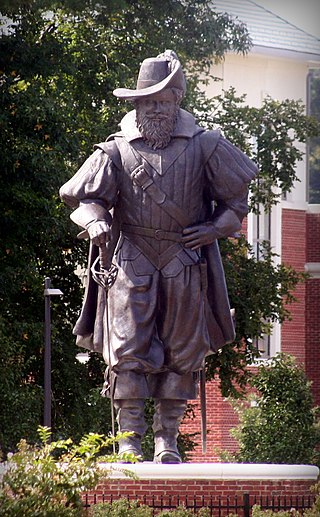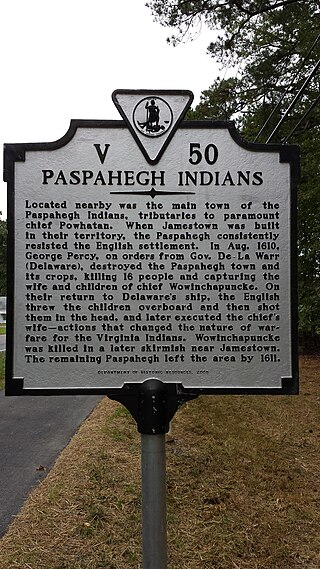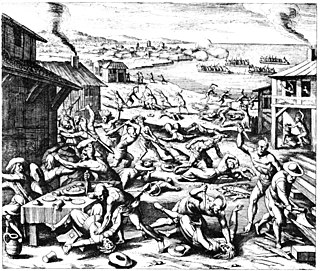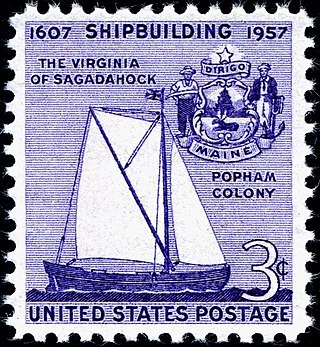
The Jamestown settlement in the Colony of Virginia was the first permanent English settlement in the Americas. It was located on the northeast bank of the James River, about 2.5 mi (4 km) southwest of the center of modern Williamsburg. It was established by the Virginia Company of London as "James Fort" on May 4, 1607 O.S., and was considered permanent after a brief abandonment in 1610. It followed several failed attempts, including the Lost Colony of Roanoke, established in 1585 on Roanoke Island, later part of North Carolina. Jamestown served as the colonial capital from 1616 until 1699. Despite the dispatch of more settlers and supplies, more than 80 percent of the colonists died in 1609–1610, mostly from starvation and disease. In mid-1610, the survivors abandoned Jamestown, though they returned after meeting a resupply convoy in the James River.

Jamestown Settlement is a living history museum operated by the Commonwealth of Virginia, created in 1957 as Jamestown Festival Park for the 350th anniversary celebration. Today it includes a recreation of the original James Fort, a Powhatan Native American town, indoor and outdoor displays, and replicas of the original settlers' ships: the Susan Constant, Godspeed, and Discovery.

The Colony of Virginia was an English, later British, colonial settlement in North America between 1606 and 1776.
Sir Samuel Argall was an English adventurer and naval officer.

Christopher Newport (1561–1617) was an English seaman and privateer. He is best known as the captain of the Susan Constant, the largest of three ships which carried settlers for the Virginia Company in 1607 on the way to found the settlement at Jamestown in the Virginia Colony, which became the first permanent English settlement in North America. He was also in overall command of the other two ships on that initial voyage, in order of their size, the Godspeed and the Discovery.

The Honourable George Percy was an English explorer, author, and early Colonial Governor of Virginia.
The Jamestown supply missions were a series of fleets from 1607 to around 1611 that were dispatched from England by the London Company with the specific goal of initially establishing the company's presence and later specifically maintaining the English settlement of "James Fort" on present-day Jamestown Island. The supply missions also resulted in the colonization of Bermuda as a supply and way-point between the colony and England.
Old Point Comfort is a point of land located in the independent city of Hampton, Virginia. Previously known as Point Comfort, it lies at the extreme tip of the Virginia Peninsula at the mouth of Hampton Roads in the United States. It was renamed Old Point Comfort to differentiate it from New Point Comfort 21 miles (34 km) up the Chesapeake Bay. A group of enslaved Africans was brought to colonial Virginia at this point in 1619. Today the location is home to Continental Park and Fort Monroe National Monument.
In the seventeenth century, Kecoughtan was the name of the settlement now known as Hampton, Virginia, In the early twentieth century, it was also the name of a town nearby in Elizabeth City County. It was annexed into the City of Newport News in 1927.

The Paspahegh tribe was a Native American tributary to the Powhatan paramount chiefdom, incorporated into the chiefdom around 1596 or 1597. The Paspahegh Indian tribe lived in present-day Charles City and James City counties, Virginia. The Powhatan Confederacy included Indigenous peoples of the Northeastern Woodlands who spoke a related Eastern Algonquian languages.
John Ratcliffe was an early Jamestown colonist, mariner and captain of Discovery, the smallest of three ships that sailed from the Kingdom of England on 19 December 1606, to English-claimed Virginia to found a colony, arriving 26 April 1607. He later became the second president of the colony of Jamestown. He was killed by the Pamunkey Native Americans in late 1609.

Sir Thomas Gates was the governor of Jamestown in the English Colony of Virginia. His predecessor, George Percy, through inept leadership, was responsible for the lives lost during the period called the Starving Time. The English-born Gates arrived to find a few surviving starving colonists commanded by Percy, and assumed command. Gates ruled with deputy governor Sir Thomas Dale. Their controlled, strict methods helped the early colonies survive. Sir Thomas was knighted in 1596 by Robert Devereux, 2nd Earl of Essex for gallantry at the Capture of Cadiz. His knighthood was later royally confirmed by Queen Elizabeth I.

Powhatan's Chimney is located at present day Wicomico, in Gloucester County, Virginia, United States.

The Anglo–Powhatan Wars were three wars fought between settlers of the Colony of Virginia and the Powhatan People of Tsenacommacah in the early 17th century. The first war started in 1609 and ended in a peace settlement in 1614. The second war lasted from 1622 to 1632. The third war lasted from 1644 until 1646 and ended when Opechancanough was captured and killed. That war resulted in a defined boundary between the Indians and colonial lands that could only be crossed for official business with a special pass. This situation lasted until 1677 and the Treaty of Middle Plantation which established Indian reservations following Bacon's Rebellion.
The Starving Time at Jamestown in the Colony of Virginia was a period of starvation during the winter of 1609–1610. There were about 500 Jamestown residents at the beginning of the winter; by spring only 61 people remained alive.
James Davis was an English ship captain and author. He was part of the expedition of the Virginia Company of Plymouth which established the short-lived Popham Colony, also called "Northern Virginia."
Queen's Creek is located in York County in the Virginia Peninsula area of the Hampton Roads region of southeastern Virginia in the United States. From a point of origin near the Waller Mill Reservoir in western York County, it flows northeasterly across the northern half of the Peninsula as a tributary of the York River.
Smith's Hundred or Smythe's Hundred was a colonial English settlement in the Province of Virginia, in the modern United States of America. It was one of the original James River plantations named after the treasurer of the Virginia Company, Sir Thomas Smith. It was settled by the English in 1617 and after 1620, was known as Southampton Hundred in honor of the Earl of Southampton. The site was originally home to a village of the Paspahegh Indians. They were located along the north bank of James River.

Virginia or Virginia of Sagadahoc was a pinnace built in 1607 and 1608 by English colonists at the Popham Colony. The ship was a project of the Plymouth Company, branch of the proprietary Virginia Company, on land England claimed as belonging to the Virginia Colony. She was the first English ocean-going vessel built in the New World, and a demonstration of the new colony's ability to build ships. The second and third "local" pinnaces were built soon afterwards in Bermuda following the loss of Sea Venture during the Third Supply.

Jamestown, also Jamestowne, was the first settlement of the Virginia Colony, founded in 1607, and served as the capital of Virginia until 1699, when the seat of government was moved to Williamsburg. This article covers the history of the fort and town at Jamestown proper, as well as colony-wide trends resulting from and affecting the town during the time period in which it was the colonial capital of Virginia.